Decomposition Rates of Suppression-Produced Fish Carcasses in a Large, Deep, High-Elevation Lake in North America
Abstract
:1. Introduction
2. Materials and Methods
2.1. Study Site
2.2. Experimental Setup and Sampling
2.3. Dry Mass Corrections
2.4. Constant Rate of Decay (k) and Half-Life
3. Results
3.1. Temperature and Dissolved Oxygen
3.1.1. Whole Carcasses in the Profundal Zone
3.1.2. Ground Carcasses in the Littoral Zone
3.2. Dry Mass Corrections
3.2.1. Whole Carcasses in the Profundal Zone
3.2.2. Ground Carcasses in Littoral Zone
3.3. Constant Rate of Decay (k) and Half-Life
4. Discussion
5. Conclusions
Author Contributions
Funding
Institutional Review Board Statement
Informed Consent Statement
Data Availability Statement
Acknowledgments
Conflicts of Interest
Appendix A
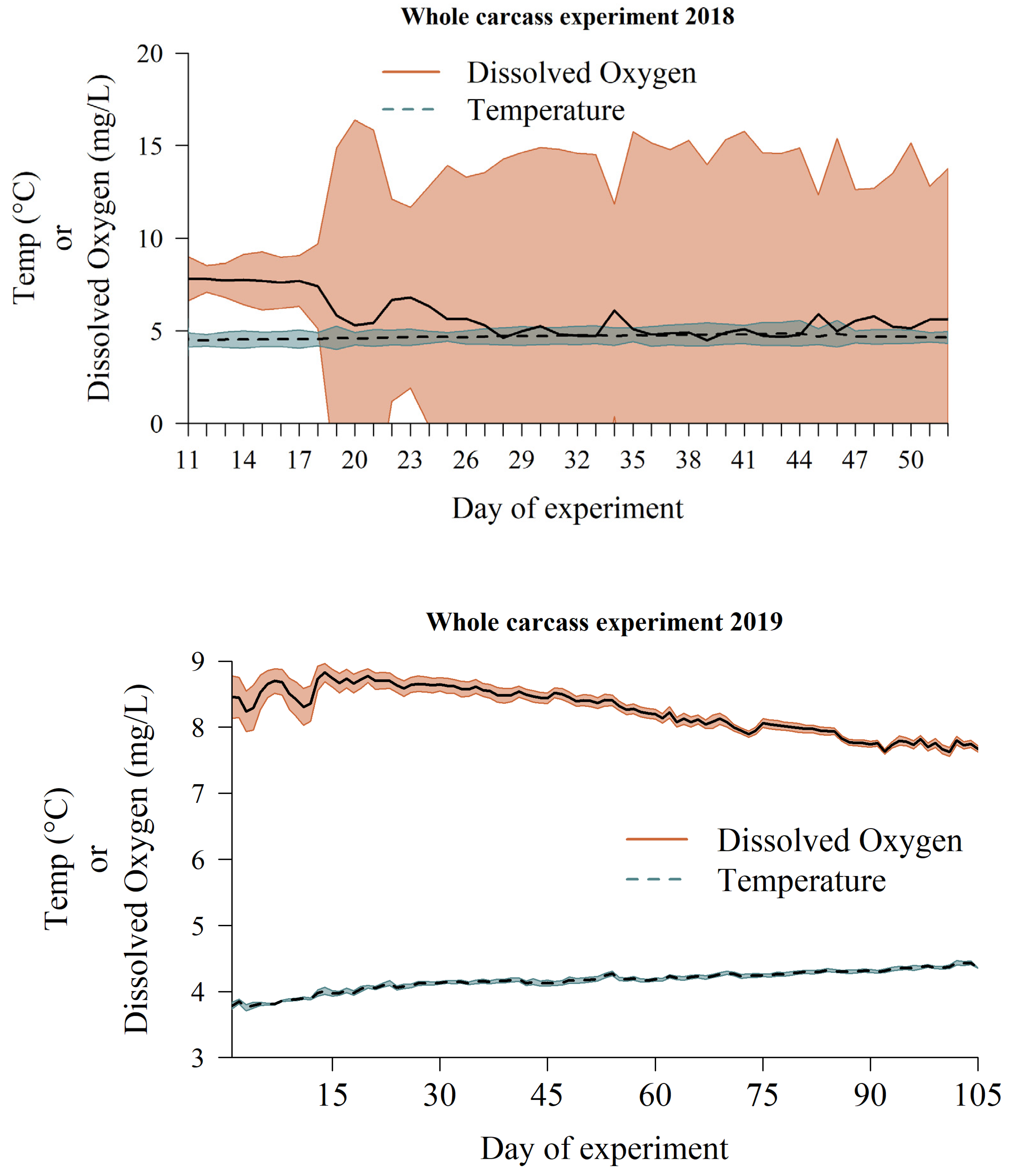

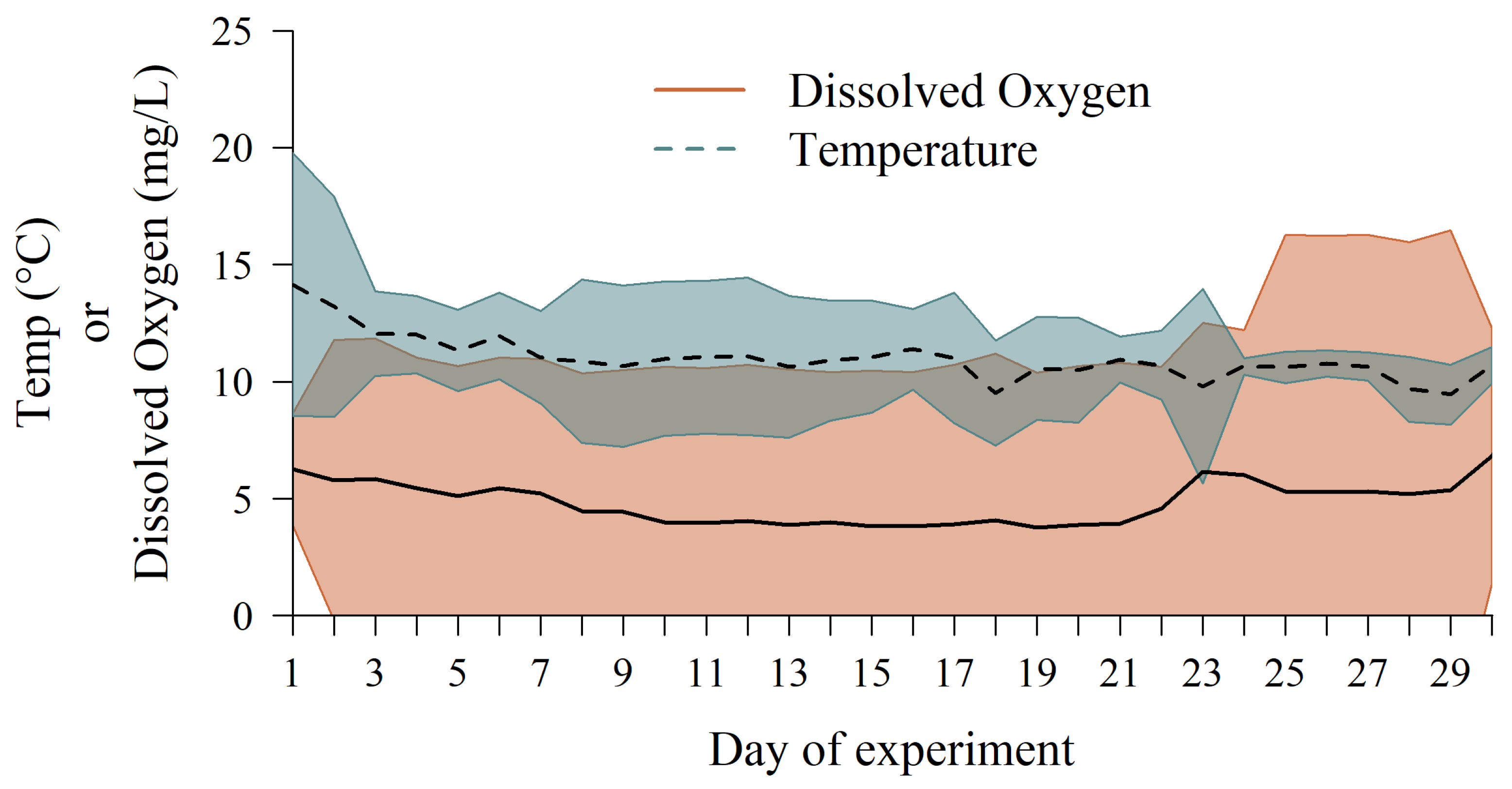
References
- Barton, P.S.; Evans, M.J.; Foster, C.N.; Pechal, J.L.; Bump, J.K.; Quaggiotto, M.-M.; Benbow, M.E. Towards Quantifying Carrion Biomass in Ecosystems. Trends Ecol. Evol. 2019, 34, 950–961. [Google Scholar] [CrossRef]
- Boyero, L.; Pearson, R.G.; Hui, C.; Gessner, M.O.; Pérez, J.; Alexandrou, M.A.; Graça, M.A.S.; Cardinale, B.J.; Albariño, R.J.; Arunachalam, M. Biotic and Abiotic Variables Influencing Plant Litter Breakdown in Streams: A Global Study. Proc. R. Soc. B Biol. Sci. 2016, 283, 20152664. [Google Scholar] [CrossRef]
- Vannote, R.L.; Minshall, G.W.; Cummins, K.W.; Sedell, J.R.; Cushing, C.E. The River Continuum Concept. Can. J. Fish. Aquat. Sci. 1980, 37, 130–137. [Google Scholar] [CrossRef]
- Webster, J.R.; Benfield, E.F. Vascular Plant Breakdown in Freshwater Ecosystems. Annu. Rev. Ecol. Syst. 1986, 17, 567–594. [Google Scholar] [CrossRef]
- Carter, D.O.; Yellowlees, D.; Tibbett, M. Cadaver Decomposition in Terrestrial Ecosystems. Naturwissenschaften 2007, 94, 12–24. [Google Scholar] [CrossRef] [Green Version]
- Smith, C.R.; Baco, A.R. Ecology of Whale Falls at the Deep-Sea FLoor. In Oceanography and Marine Biology, An Annual Review, Volume 41; CRC Press: Boca Raton, FL, USA, 2003; pp. 319–333. ISBN 0-429-21771-4. [Google Scholar]
- Towne, E.G. Prairie Vegetation and Soil Nutrient Responses to Ungulate Carcasses. Oecologia 2000, 122, 232–239. [Google Scholar] [CrossRef] [PubMed]
- Payne, L.X.; Moore, J.W. Mobile Scavengers Create Hotspots of Freshwater Productivity. Oikos 2006, 115, 69–80. [Google Scholar] [CrossRef]
- Cederholm, C.J.; Kunze, M.D.; Murota, T.; Sibatani, A. Pacific Salmon Carcasses: Essential Contributions of Nutrients and Energy for Aquatic and Terrestrial Ecosystems. Fisheries 1999, 24, 6–15. [Google Scholar] [CrossRef]
- Weaver, D.M.; Coghlan, S.M.; Zydlewski, J.; Hogg, R.S.; Canton, M. Decomposition of Sea Lamprey Petromyzon Marinus Carcasses: Temperature Effects, Nutrient Dynamics, and Implications for Stream Food Webs. Hydrobiologia 2015, 760, 57–67. [Google Scholar] [CrossRef]
- Premke, K.; Muyakshin, S.; Klages, M.; Wegner, J. Evidence for Long-Range Chemoreceptive Tracking of Food Odour in Deep-Sea Scavengers by Scanning Sonar Data. J. Exp. Mar. Biol. Ecol. 2003, 285, 283–294. [Google Scholar] [CrossRef]
- Ruxton, G.D.; Houston, D.C. Energetic Feasibility of an Obligate Marine Scavenger. Mar. Ecol. Prog. Ser. 2004, 266, 59–63. [Google Scholar] [CrossRef] [Green Version]
- Soltwedel, T.; von Juterzenka, K.; Premke, K.; Klages, M. What a Lucky Shot! Photographic Evidence for a Medium-Sized Natural Food-Fall at the Deep Seafloor. Oceanol. Acta 2003, 26, 623–628. [Google Scholar] [CrossRef] [Green Version]
- Chidami, S.; Amyot, M. Fish Decomposition in Boreal Lakes and Biogeochemical Implications. Limnol. Oceanogr. 2008, 53, 1988–1996. [Google Scholar] [CrossRef] [Green Version]
- Premke, K.; Fischer, P.; Hempel, M.; Rothhaupt, K.-O. Ecological Studies on the Decomposition Rate of Fish Carcasses by Benthic Organisms in the Littoral Zone of Lake Constance, Germany. Ann. De Limnol.-Int. J. Limnol. 2010, 46, 157–168. [Google Scholar] [CrossRef] [Green Version]
- Schneider, J.C. Fate of Dead Fish in a Small Lake. Am. Midl. Nat. 1998, 140, 192–196. [Google Scholar] [CrossRef]
- Kaeding, L.R.; Boltz, G.D.; Carty, D.G. Lake Trout Discovered in Yellowstone Lake Threaten Native Cutthroat Trout. Fisheries 1996, 21, 16–20. [Google Scholar] [CrossRef]
- Glassic, H.C.; Lujan, D.R.; Tronstad, L.M.; Briggs, M.A.; Albertson, L.K.; Koel, T.M. Diet Plasticity in an Invasive Predator Has Implications for Native Fish Conservation & Invasive Species Suppression. PLoS ONE 2023, 18, e0279099. [Google Scholar] [CrossRef]
- Koel, T.M.; Tronstad, L.M.; Arnold, J.L.; Gunther, K.A.; Smith, D.W.; Syslo, J.M.; White, P.J. Predatory Fish Invasion Induces within and across Ecosystem Effects in Yellowstone National Park. Sci. Adv. 2019, 5, eaav1139. [Google Scholar] [CrossRef] [Green Version]
- Ruzycki, J.R.; Beauchamp, D.A.; Yule, D.L. Effects of Introduced Lake Trout on Native Cutthroat Trout in Yellowstone Lake. Ecol. Appl. 2003, 13, 23–37. [Google Scholar] [CrossRef]
- Syslo, J.M.; Guy, C.S.; Koel, T.M. Feeding Ecology of Native and Nonnative Salmonids during the Expansion of a Nonnative Apex Predator in Yellowstone Lake, Yellowstone National Park. Trans. Am. Fish. Soc. 2016, 145, 476–492. [Google Scholar] [CrossRef]
- Koel, T.M.; Arnold, J.L.; Bigelow, P.E.; Brenden, T.O.; Davis, J.D.; Detjens, C.R.; Doepke, P.D.; Ertel, B.D.; Glassic, H.C.; Gresswell, R.E.; et al. Yellowstone Lake Ecosystem Restoration: A Case Study for Invasive Fish Management. Fishes 2020, 5, 18. [Google Scholar] [CrossRef]
- Varley, J.D.; Schullery, P. The Yellowstone Lake Crisis: Confronting a Lake Trout Invasion: A Report to the Director of the National Park Service; Yellowstone Center for Resources, National Park Service: Yellowstone National Park, WY, USA, 1995.
- Koel, T.M.; Bigelow, P.E.; Doepke, P.D.; Ertel, B.D.; MacDonald, D.J.; Puchany, A.R.; Vender, C.W. Native Fish Conservation Program, Yellowstone National Park, Report for 2022; National Park Service, Yellowstone Center for Resources: Yellowstone National Park, WY, USA, 2023.
- Poole, A.S.; Koel, T.M.; Thomas, N.A.; Zale, A.V. Benthic Suffocation of Invasive Lake Trout Embryos by Fish Carcasses and Sedimentation in Yellowstone Lake. N. Am. J. Fish. Manag. 2020, 40, 1077–1086. [Google Scholar] [CrossRef]
- Thomas, N.A.; Guy, C.S.; Koel, T.M.; Zale, A.V. In-Situ Evaluation of Benthic Suffocation Methods for Suppression of Invasive Lake Trout Embryos in Yellowstone Lake. N. Am. J. Fish. Manag. 2019, 39, 104–111. [Google Scholar] [CrossRef]
- Kilham, S.S.; Theriot, E.C.; Fritz, S.C. Linking Planktonic Diatoms and Climate Change in the Large Lakes of the Yellowstone Ecosystem Using Resource Theory. Limnol. Oceanogr. 1996, 41, 1052–1062. [Google Scholar] [CrossRef]
- Koel, T.; Arnold, J.; Bigelow, P.; Doepke, P.; Ertel, B.; Ruhl, M. Yellowstone Fisheries and Aquatic Sciences: Annual Report, 2006; National Park Service: Yellowstone National Park, WY, USA, 2007.
- Benson, N.G. Limnology of Yellowstone Lake in Relation to the Cutthroat Trout; US Fish and Wildlife Service: Bailey’s Crossroads, VA, USA, 1961.
- Kaplinski, M.A. Geomorphology and Geology of Yellowstone Lake, Yellowstone National Park, Wyoming; Northern Arizona University: Flagstaff, AZ, USA, 1991. [Google Scholar]
- Lantry, B.F.; O’Gorman, R. Drying Temperature Effects on Fish Dry Mass Measurements. J. Great Lakes Res. 2007, 33, 606–616. [Google Scholar] [CrossRef]
- Elliott, J.M. An Experimental Study on the Natural Removal of Dead Trout Fry in a Lake District Stream. J. Fish Biol. 1997, 50, 870–877. [Google Scholar] [CrossRef]
- Enriquez, S.; Duarte, C.M.; Sand-Jensen, K. Patterns in Decomposition Rates among Photosynthetic Organisms: The Importance of Detritus C:N:P Content; Springer: Berlin/Heidelberg, Germany, 1993; Volume 94. [Google Scholar]
- R Core Team. R: A Language and Environment for Statistical Computing; R Core Team: Vienna, Austria, 2022. [Google Scholar]
- Hargrave, B.T. Aerobic Decomposition of Sediment and Detritus as a Function of Particle Surface Area and Organic Content. Limnol. Oceanogr. 1972, 17, 583–586. [Google Scholar] [CrossRef]
- Pabst, S.; Scheifhacken, N.; Hesselschwerdt, J.; Wantzen, K.M. Leaf Litter Degradation in the Wave Impact Zone of a Pre-Alpine Lake. In Ecological Effects of Water-Level Fluctuations in Lakes; Springer: Berlin/Heidelberg, Germany, 2008; pp. 117–131. [Google Scholar]
- Minshall, G.W.; Hitchcock, E.; Barnes, J.R. Decomposition of Rainbow Trout Carcasses in a Forest Stream Ecosystem Inhabited Only by Nonanadromous Fish Populations. Can. J. Fish. Aquat. Sci. 1991, 48, 191–195. [Google Scholar] [CrossRef]
- Fenoglio, S.; Bo, T.; Agosta, P.; Cucco, M. Mass Loss and Macroinvertebrate Colonisation of Fish Carcasses in Riffles and Pools of a NW Italian Stream. Hydrobiologia 2005, 532, 111–112. [Google Scholar] [CrossRef]
- Parmenter, R.R.; Lamarra, V.A. Nutrient Cycling in a Freshwater Marsh: The Decomposition of Fish and Waterfowl Carrion. Limnol. Oceanogr. 1991, 36, 976–987. [Google Scholar] [CrossRef]
- Jannasch, H.W.; Wirsen, C.O. Alvin and the Sandwich. Oceanus 1972, 16, 20–22. [Google Scholar]
- Ogada, D.L.; Torchin, M.E.; Kinnaird, M.F.; Ezenwa, V.O. Effects of Vulture Declines on Facultative Scavengers and Potential Implications for Mammalian Disease Transmission. Conserv. Biol. 2012, 26, 453–460. [Google Scholar] [CrossRef]
- Briggs, M.; Albertson, L.; Lujan, D.; Tronstad, L.; Glassic, H.; Guy, C.; Koel, T. Carcass Deposition to Suppress Invasive Lake Trout Causes Differential Mortality of Two Common Benthic Invertebrates in Yellowstone Lake. Fundam. Appl. Limnol./Arch. Für Hydrobiol. 2020, 194, 285–295. [Google Scholar] [CrossRef]
- Wilmot, O.; Tronstad, L.; Hall, R.O.; Koel, T.; Arnold, J. Lake Trout–Induced Spatial Variation in the Benthic Invertebrates of Yellowstone Lake. Park Sci. 2016, 32, 25–35. [Google Scholar]
- Burkepile, D.E.; Parker, J.D.; Woodson, C.B.; Mills, H.J.; Kubanek, J.; Sobecky, P.A.; Hay, M.E. Chemically Mediated Competition between Microbes and Animals: Microbes as Consumers in Food Webs. Ecology 2006, 87, 2821–2831. [Google Scholar] [CrossRef] [PubMed]
- Bigelow, P.E. Predicting Areas of Lake Trout Spawning Habitat within Yellowstone Lake, Wyoming; University of Wyoming: Laramie, WY, USA, 2009; ISBN 1-109-53178-8. [Google Scholar]
- Lujan, D.R.; Tronstad, L.M.; Briggs, M.A.; Albertson, L.K.; Glassic, H.C.; Guy, C.S.; Koel, T.M. Response of Nutrient Limitation to Invasive Fish Suppression: How Carcasses and Analog Pellets Alter Periphyton. Freshw. Sci. 2022, 41, 88–99. [Google Scholar] [CrossRef]
- Griffiths, D. The Direct Contribution of Fish to Lake Phosphorus Cycles. Ecol. Freshw. Fish 2006, 15, 86–95. [Google Scholar] [CrossRef]
- Sereda, J.M.; Hudson, J.J.; Taylor, W.D.; Demers, E. Fish as Sources and Sinks of Nutrients in Lakes. Freshw. Biol. 2008, 53, 278–289. [Google Scholar]
- Lujan, D.R.; Tronstad, L.M.; Briggs, M.A.; Albertson, L.K.; Glassic, H.C.; Guy, C.S.; Koel, T.M. Suppressing an Invasive Apex Predator Minimally Alters Nitrogen Dynamics in Yellowstone Lake, Wyoming. Hydrobiologia, 2022; in review. [Google Scholar]
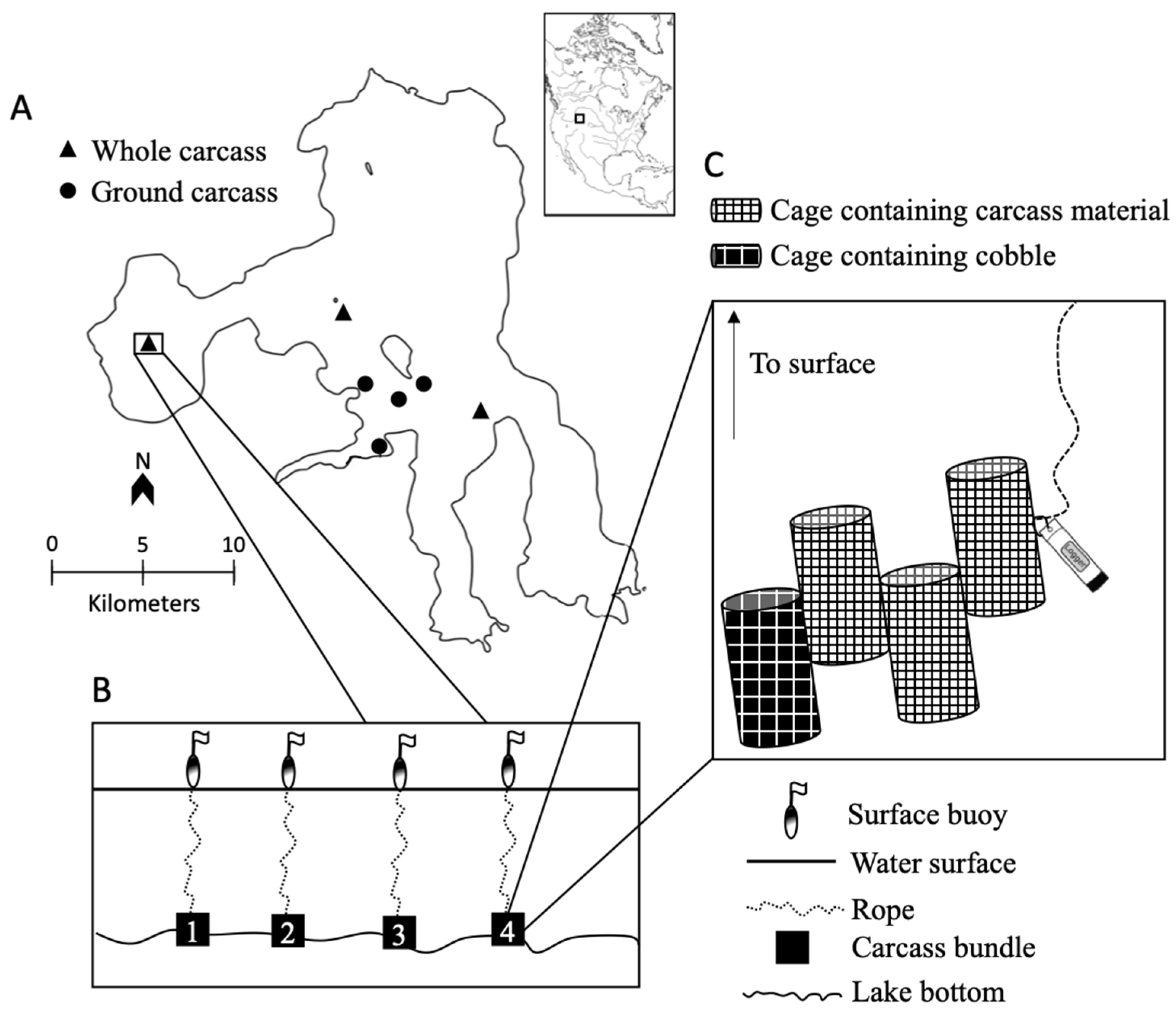
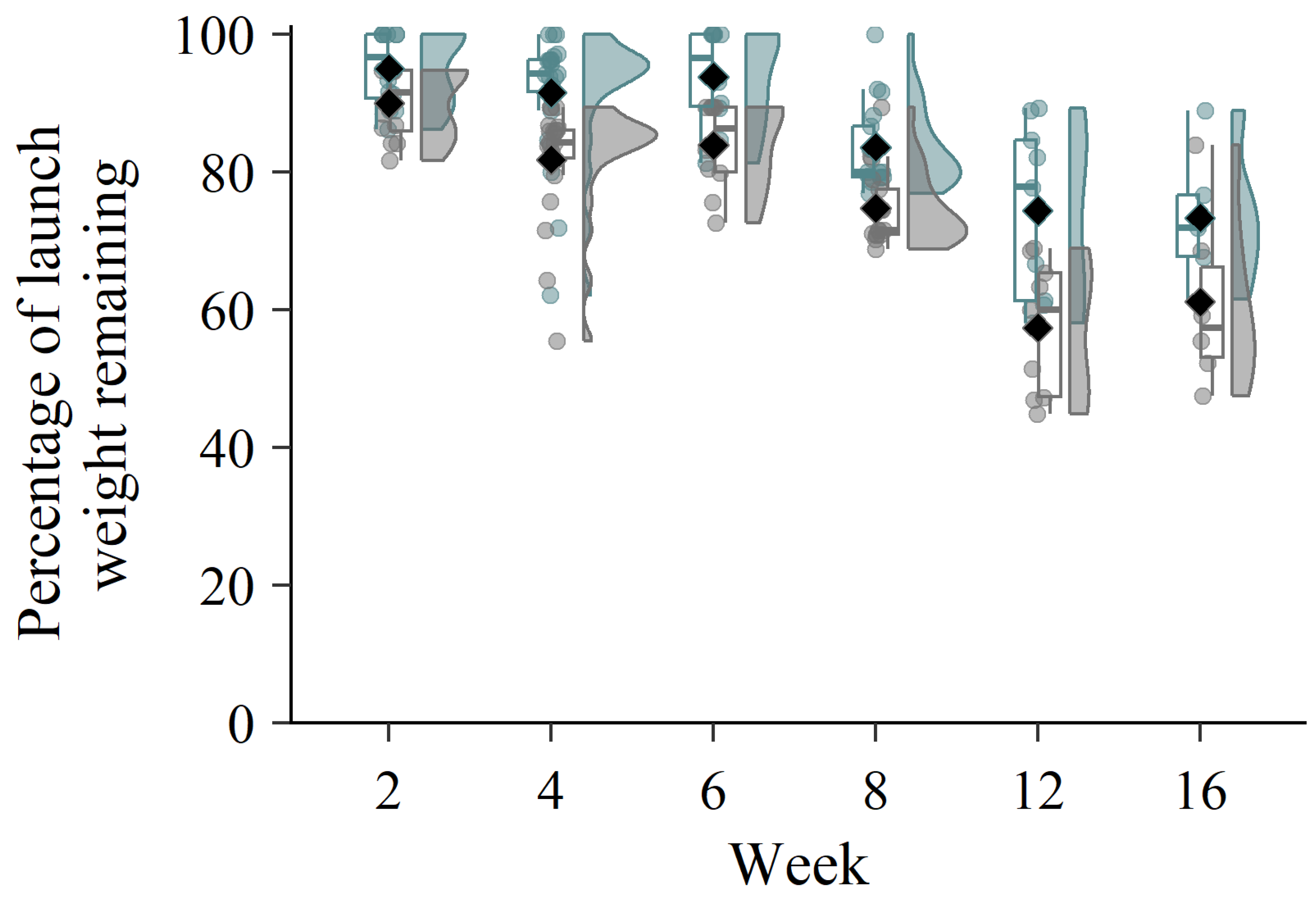
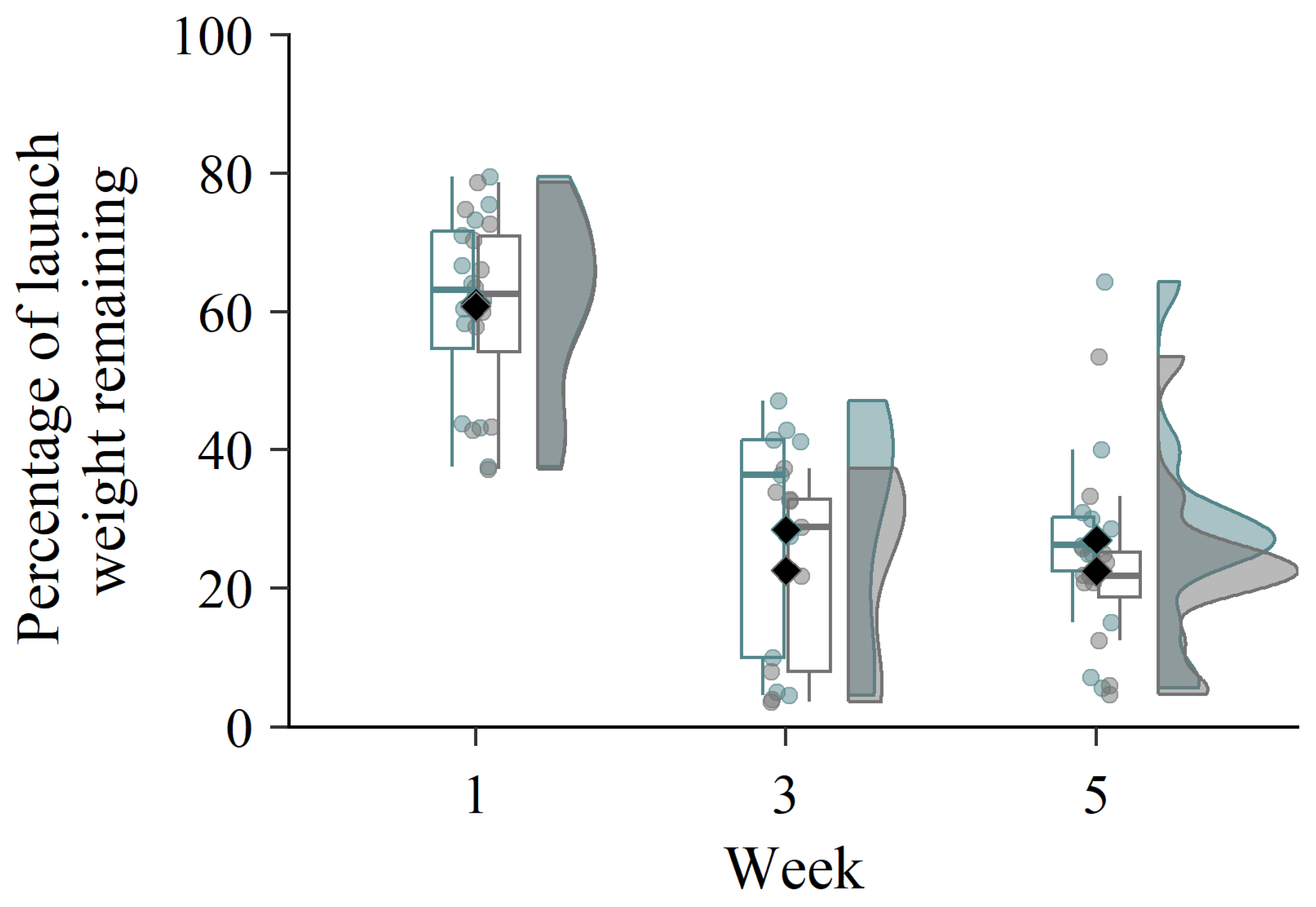

| Carcass State | Year | Experiment Weeks | Depth | Total Number Cages with Carcass | Total Number Bundles |
|---|---|---|---|---|---|
| Whole | 2018 | 2, 4, 6, 8 | >70 m | 48 | 16 |
| 2019 | 4, 8, 12, 16 | >70 m | 36 | 12 | |
| Ground | 2018 | 1, 3, 5 | 10 m | 36 | 12 |
| Carcass State | Week | DM (% of Wet Mass; [CI]) | Method |
|---|---|---|---|
| Whole | 2 | 24.5 [21.3–27.7] | Literature-derived [30] |
| 4 | 21.9 [18.9–24.9] | Dried in lab | |
| 6 and 8 | 21.9 | Assumed to = week 4 | |
| 12 and 16 | 18.9 | Assumed to = lower CI week 4 | |
| Ground | 0 | 32.2 [30.1–34.4] | Dried in lab |
| 1 | 31.9 [28.4–35.4] | Dried in lab | |
| 2 | 25.5 [24.8–26.3] | Dried in lab | |
| 3 | 26.1 | Assumed to = average weeks 2 and 4 | |
| 4 | 26.8 [23.7–29.8] | Dried in lab | |
| 5 | 26.8 | Assumed to = week 4 |
Disclaimer/Publisher’s Note: The statements, opinions and data contained in all publications are solely those of the individual author(s) and contributor(s) and not of MDPI and/or the editor(s). MDPI and/or the editor(s) disclaim responsibility for any injury to people or property resulting from any ideas, methods, instructions or products referred to in the content. |
© 2023 by the authors. Licensee MDPI, Basel, Switzerland. This article is an open access article distributed under the terms and conditions of the Creative Commons Attribution (CC BY) license (https://creativecommons.org/licenses/by/4.0/).
Share and Cite
Glassic, H.C.; Guy, C.S.; Tronstad, L.M.; Briggs, M.A.; Albertson, L.K.; Lujan, D.R.; Koel, T.M. Decomposition Rates of Suppression-Produced Fish Carcasses in a Large, Deep, High-Elevation Lake in North America. Fishes 2023, 8, 385. https://doi.org/10.3390/fishes8080385
Glassic HC, Guy CS, Tronstad LM, Briggs MA, Albertson LK, Lujan DR, Koel TM. Decomposition Rates of Suppression-Produced Fish Carcasses in a Large, Deep, High-Elevation Lake in North America. Fishes. 2023; 8(8):385. https://doi.org/10.3390/fishes8080385
Chicago/Turabian StyleGlassic, Hayley C., Christopher S. Guy, Lusha M. Tronstad, Michelle A. Briggs, Lindsey K. Albertson, Dominique R. Lujan, and Todd M. Koel. 2023. "Decomposition Rates of Suppression-Produced Fish Carcasses in a Large, Deep, High-Elevation Lake in North America" Fishes 8, no. 8: 385. https://doi.org/10.3390/fishes8080385





